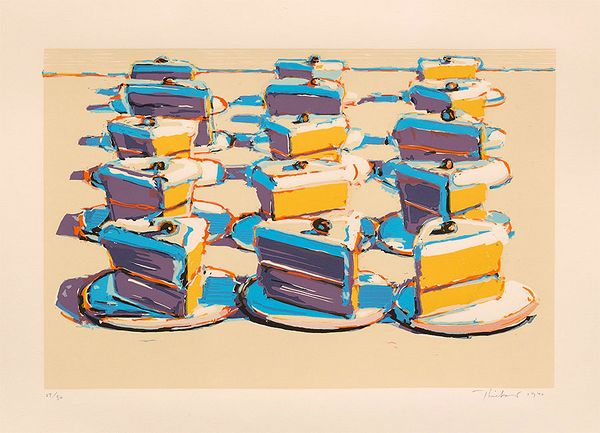Wayne Thiebaud, Boston Cremes, from Seven Still Lifes and a Silver Landscape, 1971. Editions & Works on Paper New York.
Phillips is proud to offer 10 works from the Family Collection of Harry W. and Mary Margaret Anderson as a single-owner section in the Editions Evening Sale on 19 April. Comprised of select master prints by Jasper Johns and Wayne Thiebaud, these new-to-auction impressions formed part of Harry W. (Hunk) and Mary Margaret (Moo)’s larger, historical collection of contemporary American prints, paintings, drawings and sculpture acquired during their lifetime in the San Francisco Bay Area.
In art collecting, timing is everything. Recalling a fateful visit to the Louvre in 1964 which would set in motion a lifelong passion for she and husband Harry “Hunk” Anderson, Mary Margaret “Moo” Anderson noted: “Art was someone we played tennis or golf with before this trip.” Returning to California shortly thereafter, the couple’s early collecting pace was tremendous, tracking down and acquiring works by Claude Monet, Henri Matisse, Emil Nolde, Pablo Picasso, as well as early American Modernists artists such as Georgia O’Keeffe, Marsden Hartley and Arthur Dove.
Timing would again come into play in the late 1960s, when the Andersons realized that Impressionist and Modernist works were rarely available at market – concurrently, a thriving printmaking renaissance led them into American prints and turned the Anderson’s eyes to the world of contemporary artists on the forefront of experimentation. By 1969, the Andersons made the decision to concentrate exclusively on postwar American art – of which prints became an entry point for Hunk and Moo to familiarize themselves with emerging names.
Through print workshops, we were exposed to new artists. They acted as a kind of filter for us, enabling us to ultimately select certain key artists. From there we would purchase prints and then perhaps paintings or drawings.
- Harry W. Anderson
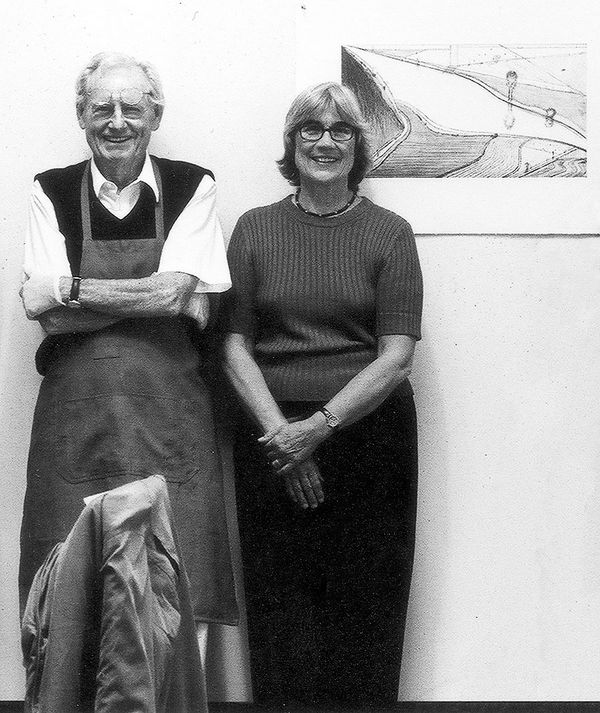
Wayne Thiebaud with Kathan Brown, founding director of Crown Point Press, in the Crown Point studio, 2002.
Print workshops such as Gemini G.E.L., Crown Point Press, and Universal Limited Art Editions had established themselves as spaces where artists could produce beautifully made editions and innovate the form through technical advances. Gemini G.E.L. in particular espoused a no-project-too-small mentality which resulted in brilliant large-scale works by Robert Rauschenberg. His 1967 work, Booster, was the largest print ever created by hand lithography. Rauschenberg in turn attracted Jasper Johns to making prints, and subsequently whose work was first introduced to the Andersons at Gemini G.E.L. in Los Angeles the following year. The Andersons enthusiastically subscribed and acquired all editions (lithographs and object multiples) by Jasper Johns. Universal Limited Art Editions (U.L.A.E.) in Long Island, New York, with its focus on intaglio printmaking, eventually gave them another key source for collecting Johns' works.
The Andersons were always truly passionate about fine art printmaking, quoted by the couple as being “their first love,” even entering the printing and publishing business in 1978, forming 3EP Ltd. Press, devoted to monotype and unique printmaking forms. By the late 70s, they were often traveling to studios and print workshops themselves to cultivate friendships with artists who were at that point significant figures in American art and printmaking, including Ellsworth Kelly and Kenneth Tyler, a Gemini printer who went on to form Tyler Graphics. The workshop environment and ever-expanding artistic scope of the works they witnessed inspired the Andersons to further their support of innovations in the medium, leading as well to their daughter, Putter Pence, who expanded 3EP to Los Angeles and opened her own gallery to showcase these prints along with other contemporary editions.
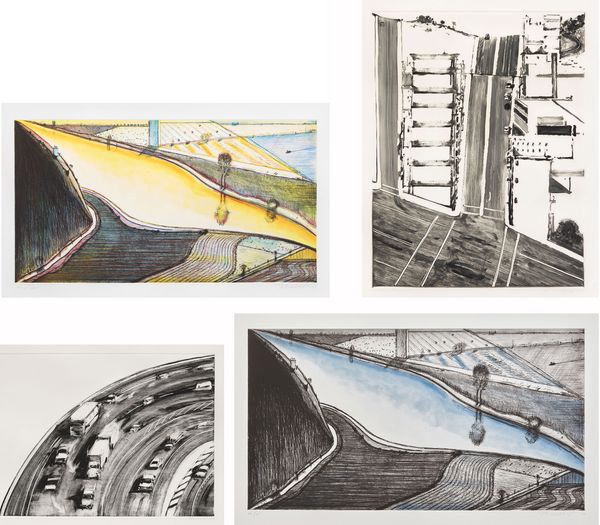
Clockwise from top right: Wayne Thiebaud, Twin Peaks Downgrade #1, 1977. Editions & Works on Paper New York. Wayne Thiebaud, Dark Hill River, 2002. Editions & Works on Paper New York. Wayne Thiebaud, Freeway Curve, 1977. Editions & Works on Paper New York. Wayne Thiebaud, Hill River, 2002. Editions & Works on Paper New York.
The earliest prints in the selection are Wayne Thiebaud’s 1971 linocut Boston Cremes and lithograph Rabbit from two different series of seven images published by Parasol Press, Ltd., New York, which were purchased at Albert Smith’s Menlo Park hallery near the Anderson’s home in Atherton. The finely etched and colored confection Four Cakes, from the Recent Etchings #1 series, was also published by Parasol Press was acquired from the Smith Andersen Gallery in nearby Palo Alto. Thiebaud’s two unique printed drawing monotypes were purchased directly from the artist in 1978 — Freeway Curve and Twin Peaks Downgrade #1 are lush examples of his urban speedway caricature and San Francisco street architecture. The complimentary pair of dry point etchings Lipsticks-Black and Eight Lipsticks and the color variations of pastoral Hill River and Dark Hill River, illuminating the Sacramento delta country near Thiebaud’s studio, were printed and published by Kathan Brown’s Crown Point Press in San Francisco.
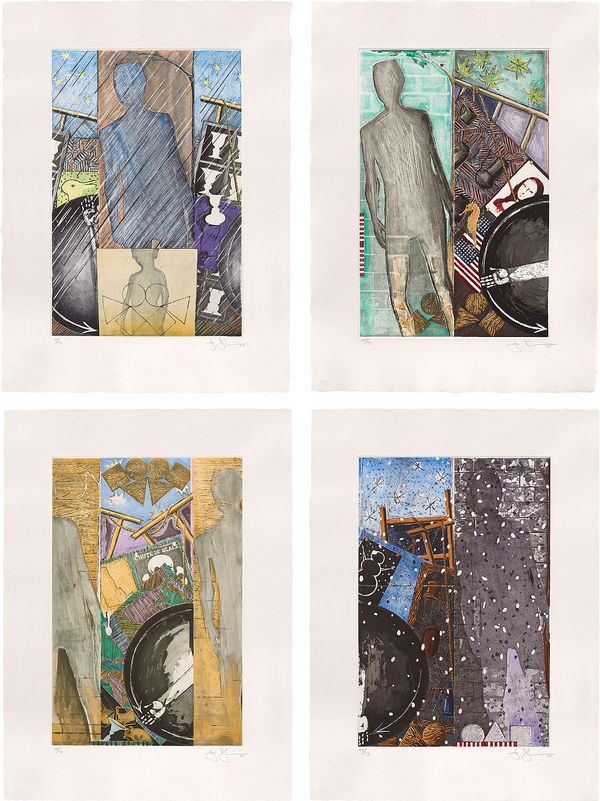
Jasper Johns, The Seasons (ULAE 238-241), 1987. Editions & Works on Paper New York.
Jasper Johns’ iconic four image series, The Seasons, is a standout example of the artist’s inspired printmaking and the Anderson family’s “head and hands” approach to collecting: a union of the “head,” or the concept and ingenuity, and the “hands” of the artisanship and materials employed by the work. Layers of marks and symbolism are most evident in his etching and aquatint depicts the different studios where the paintings on which these are based were created: Stony Point, New York (Spring), St. Martin in the French West Indies (Summer), Houston Street, New York City (Fall), and East 63rd Street, New York City (Winter), along with the artist’s personal artifacts and fragmented imagery from earlier works. Throughout the 1980s and 90s, Putter’s gallery and close ties to contemporary artists were touchpoints for the family print collection as it continued to embrace the medium and introduce other artists to the mix.
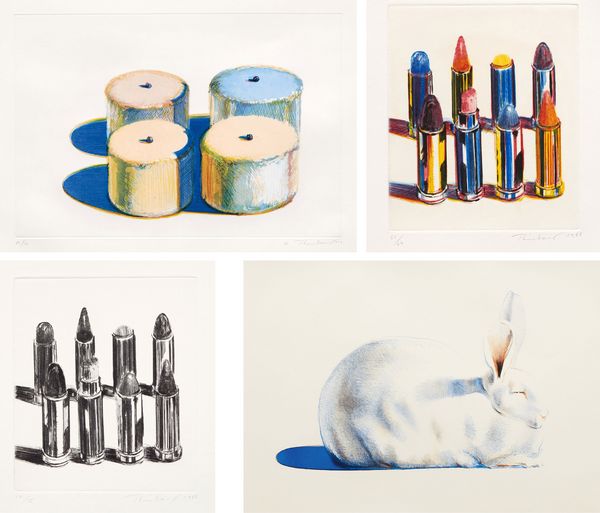
Clockwise from top right: Wayne Thiebaud, Eight Lipsticks, 1988. Editions & Works on Paper New York. Wayne Thiebaud, Rabbit, from Seven Still Lifes and a Rabbit, 1971. Editions & Works on Paper New York. Wayne Thiebaud, Lipsticks-Black, 1988. Editions & Works on Paper New York. Wayne Thiebaud, Four Cakes, from Recent Etchings I, 1979. Editions & Works on Paper New York.
Hunk and Moo took an approach to displaying their collection that was as contemporary as the collection itself – guests at their home would walk under an Alexander Calder mobile en route to viewing a Jasper Johns work above a bedroom headboard, and over time the collection expanded throughout the house, into their garden, and eventually onto the walls of countless institutions through extraordinary donations. In 1996, the Andersons gifted 656 print works to the Fine Art Museum of San Fransisco, resulting in the creation of the Anderson Gallery of Contemporary Graphic Art in 1997. The Anderson Collection at Stanford University opened in 2014 and houses many of the core works from the acquisitions Hunk and Moo so distinctively oversaw – ever the courteous stewards, they believed themselves custodians of the works, and their dedication to artists and the craft of printmaking is abundantly clear in this exceptional group of works.
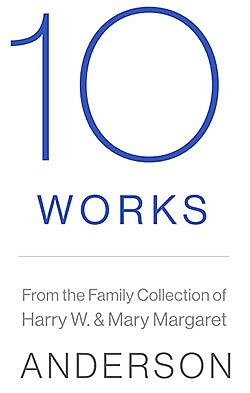
Discover More from Editions & Works on Paper >
Recommended Reading
